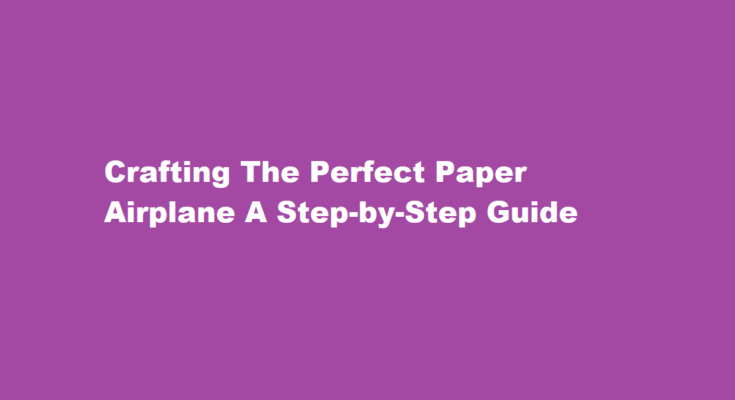Introduction
Paper airplanes have fascinated both young and old for generations. The simple pleasure of folding a piece of paper into a sleek flying machine and watching it soar through the air never fails to bring joy. Although seemingly effortless, creating a paper airplane that flies well requires precision and careful design. In this article, we will explore the art of making a paper airplane by providing a step-by-step guide and some valuable tips to enhance your folding technique. Get ready to unleash your inner aviator!
Materials Needed
Before embarking on your paper airplane journey, gather the following materials
- A standard letter-sized piece of paper (8.5 x 11 inches or A4 size)
- A flat and smooth surface for folding
- A ruler (optional, but helpful for precise measurements)
- Your creativity and enthusiasm!
Choosing the Right Paper
The foundation of a successful paper airplane lies in selecting the appropriate paper. Ideally, use lightweight paper like standard printer paper or origami paper. Avoid using heavy cardstock as it may hinder the plane’s ability to fly smoothly. The paper’s condition is also crucial; ensure it is clean and free from tears to achieve the best flight performance.
Basic Fold
Lay the paper horizontally on the flat surface in front of you. Take the top edge of the paper and fold it down to meet the bottom edge. Make sure the corners align neatly. Crease the fold firmly using your fingers or the ruler. This fold creates a central crease down the middle of the paper, dividing it into two equal halves.
Wing Fold
Now, bring the top left corner down to meet the central crease, forming a triangle on the left side. Repeat the same step on the right side, bringing the top right corner down to match the central crease. This creates two smaller triangles with their bases aligned along the central crease.
Fuselage
Fold the two smaller triangles along the central crease, so their edges meet, forming a slender shape resembling an elongated diamond. This is the fuselage of your paper airplane, which provides stability during flight.
Wings
To craft the wings, fold the paper along the central crease, bringing the top edge down to align with the bottom edge. The wings should now extend out horizontally from the fuselage. The angle at which you fold the wings will affect the plane’s stability and flight pattern. Experiment with different angles to find the best one for your design.
Tail
The tail of the paper airplane aids in stability and balance during flight. Fold the top edges of the wings slightly outward, perpendicular to the fuselage. This subtle fold ensures a smoother flight trajectory.
Tips for Improvement
1. Precision is key Accurate folding and creasing are essential for a well-balanced airplane.
2. Experiment with wing shapes Try folding the wings at different angles or giving them a slight dihedral (upward bend) for improved stability.
3. Weight distribution For longer flights, place a paperclip or a small piece of tape near the nose of the plane to shift the center of gravity forward.
4. Paper thickness Thinner paper tends to produce more delicate planes suitable for indoor flights, while thicker paper can handle outdoor conditions better.
FREQUENTLY ASKED QUESTIONS
How to make a plane on paper?
To make a simple paper airplane, first fold a piece of paper in half lengthwise. Then, unfold it and fold the top 2 corners to the center. Next, fold the angled edges that you just created towards the center, leaving about 1 cm of space between the bottom of the angled edges and the crease.
What is the longest paper airplane flight?
It’s a paper airplane! The world record for the farthest flight by paper airplane has been broken by three aerospace engineers with a paper aircraft that flew a grand total of 289 feet, 9 inches (88 meters), nearly the length of an American football field.
Conclusion
Creating a paper airplane is not only an enjoyable pastime but also an excellent way to understand basic principles of flight. With practice and experimentation, you can design your unique flying creations. So, grab a piece of paper, fold it skillfully, and unleash your imagination to witness your paper airplane soar to new heights! Happy flying!
Read Also : How to Interpret a Financial Statement Unveiling the Financial Health of a Business



